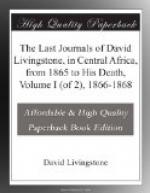The Lakelet Mofwe fills during the rains and spreads westward, much beyond its banks. Elephants wandering in its mud flats when covered are annually killed in numbers: if it were connected with the Lake Moero the flood would run off.
Many of Casembe’s people appear with the ears cropped and hands lopped off: the present chief has been often guilty of this barbarity. One man has just come to us without ears or hands: he tries to excite our pity making a chirruping noise, by striking his cheeks with the stumps of his hands.
A dwarf also, one Zofu, with backbone broken, comes about us: he talks with an air of authority, and is present at all public occurrences: the people seem to bear with him. He is a stranger from a tribe in the north, and works in his garden very briskly: his height is 3 feet 9 inches.
FOOTNOTES:
[56] Chefu amongst the Manganja. Any animal possessing strength, has the terminal “fu” or “vu;” thus Njobvu, an elephant; M’vu, the hippopotamus.—ED.
[57] The natives are quick to detect a peculiarity in a man, and give him a name accordingly: the conquerors of a country try to forestall them by selecting one for themselves. Susi states that when Tipo Tipo stood over the spoil taken from Nsama, he gathered it closer together and said, “Now I am Tipo Tipo,” that is, “the gatherer together of wealth.” Kumba Kumba, of whom we shall hear much, took his name from the number of captives he gathered in his train under similar circumstances; it might be translated, “the collector of people.”—ED.
[58] It is on the West Coast alone that idols are really worshipped in Africa.—ED.
CHAPTER X.
Grand reception of the traveller. Casenibe and his wife. Long stay in the town. Goes to explore Moero. Despatch to Lord Clarendon, with notes on recent travels. Illness at the end of 1867. Further exploration of Lake Moero. Flooded plains. The River Luao. Visits Kabwawata. Joy of Arabs at Mohamad bin Saleh’s freedom. Again ill with fever. Stories of underground dwellings.
24th November, 1867.—We were called to be presented to Casembe in a grand reception.
The present Casembe has a heavy uninteresting countenance, without beard or whiskers, and somewhat of the Chinese type, and his eyes have an outward squint. He smiled but once during the day, and that was pleasant enough, though the cropped ears and lopped hands, with human skulls at the gate, made me indisposed to look on anything with favour. His principal wife came with her attendants, after he had departed, to look at the Englishman (Moenge-rese). She was a fine, tall, good-featured lady, with two spears in her hand; the principal men who had come around made way for her, and called on me to salute: I did so; but she, being forty yards off, I involuntarily beckoned her to come nearer: this upset the gravity of all her attendants; all burst into a laugh, and ran off.




